I agree Our site saves small pieces of text information (cookies) on your device in order to deliver better content and for statistical purposes. You can disable the usage of cookies by changing the settings of your browser. By browsing our website without changing the browser settings you grant us permission to store that information on your device.
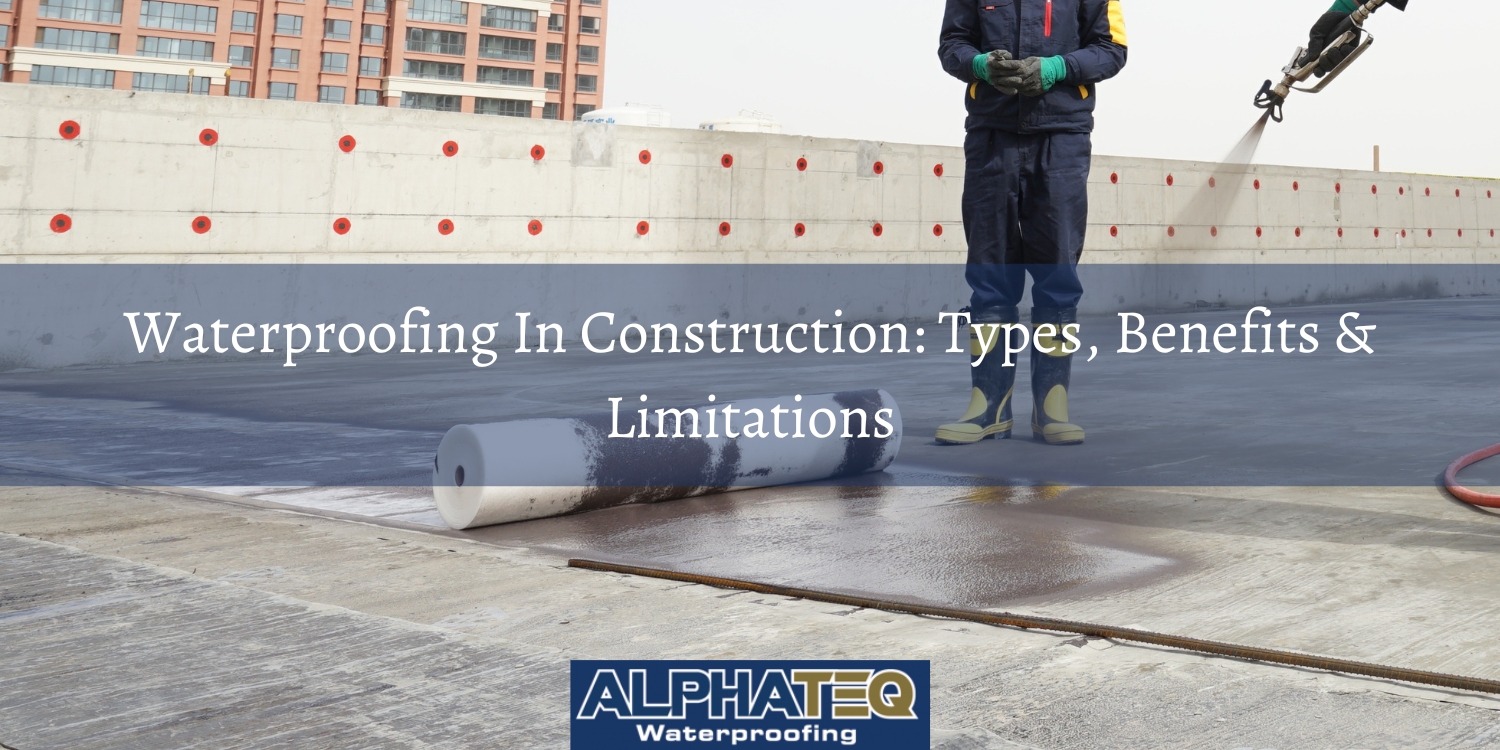
Waterproofing is the process of applying materials in cohesion with construction methods to protect a structure from both water damage and infiltration. This process revolves around creating a barrier or system (waterproofing membrane) which prevents water from entering the building envelope. This ensures the longevity and structural integrity of the building being waterproofed.
Waterproofing in construction is crucial. It preserves the structural integrity and enhances the longevity of buildings by preventing water damage. Successful waterproofing ensures structures remain free from water infiltration. If a structure is infiltrated by water it can lead to adverse events such as building deterioration, mould growth, and structural instability.
Another important aspect of waterproofing is providing a healthy indoor environment. This is done by preventing moisture related issues developing. This includes dampness and musty odours. Both of which can lead to potential health hazards. Effective waterproofing can also minimise maintenance and repair costs over the service life of the waterproofing membrane. Choosing a quality waterproofing membrane can also enhance the energy efficiency of a building by preventing heat loss and water leakage.
Addressing any water-related issues in a building are of paramount importance for several reasons.
Addressing water-related issues in construction projects is essential. It will safeguard the structure, ensure the health of the people inside the building, minimise maintenance costs, and promote sustainable practices. It is a critical aspect of responsible construction. Therefore, it is vital to give waterproofing the utmost attention and consideration.
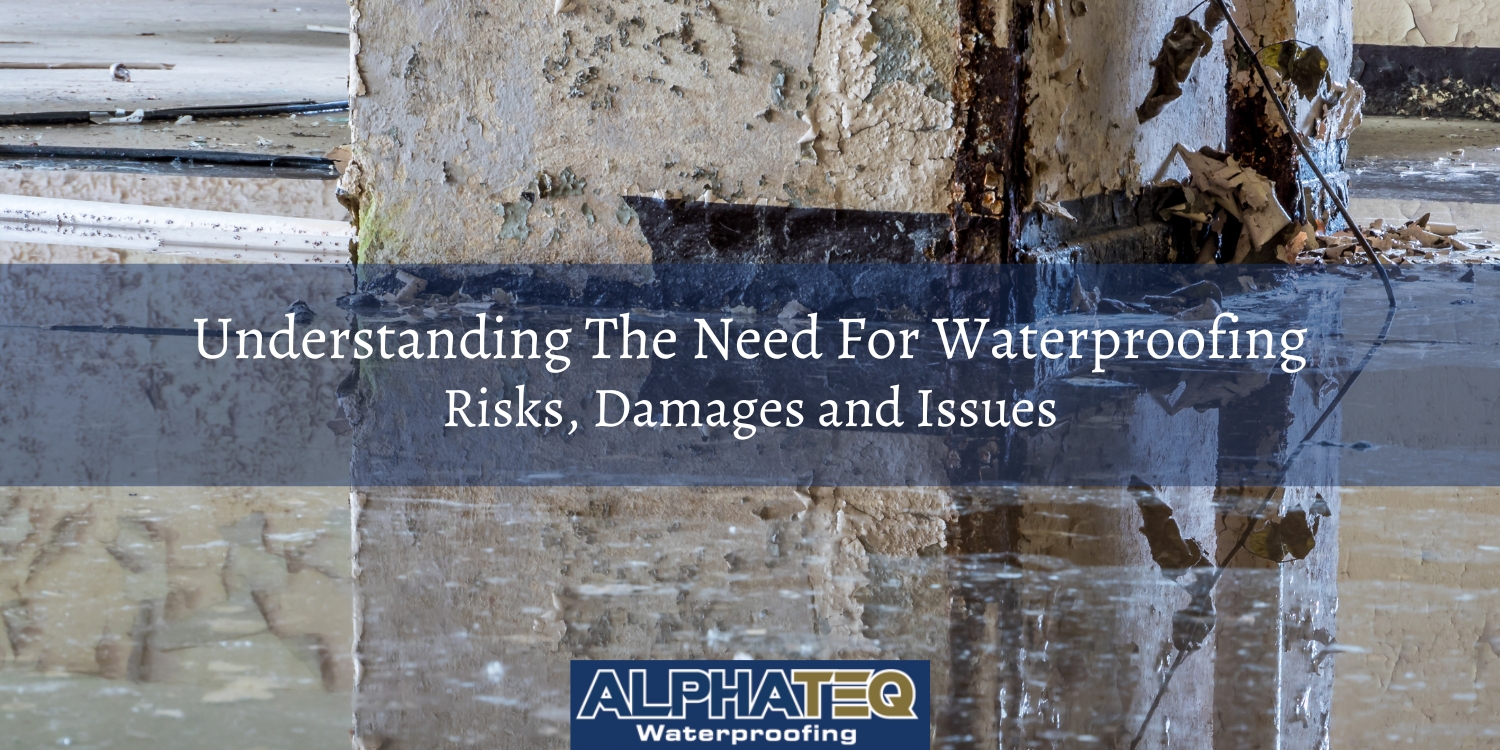
Water intrusion poses significant risks for any building. The reason for this is water damage can cause large scale damage with high average costs to repair. This means taking necessary care to ensure sound waterproofing is essential. It is much better to keep water away than having to react to water damage. To highlight this it is an excellent idea to understand the impact moisture can have on different building materials. Once the common water-related issues in construction are understood the importance of effective waterproofing becomes evident.
Moisture can have varying effects on different building materials. Wood is a construction material which is highly susceptible to moisture absorption. This can result in swelling, warping, and decay. Concrete and masonry can suffer from cracking, efflorescence, and freeze-thaw damage when exposed to water. Metal elements are prone to corrosion and rusting, compromising their strength and structural integrity. Understanding each of these material specific vulnerabilities is important when deciding on the waterproofing strategy for your building.
A leaking roof, an inadequate drainage system, water seepage through foundation walls, and water penetration through cracks or gaps in the building envelope are common water related issues buildings suffer from.
These instances of moisture infiltration from sources like rain, groundwater, or plumbing failures can result in a number of problems. This includes water stains, mould growth, musty odours, and compromised building performance. Proactive waterproofing strategies are imperative to minimise the probability of any of these issues occurring.
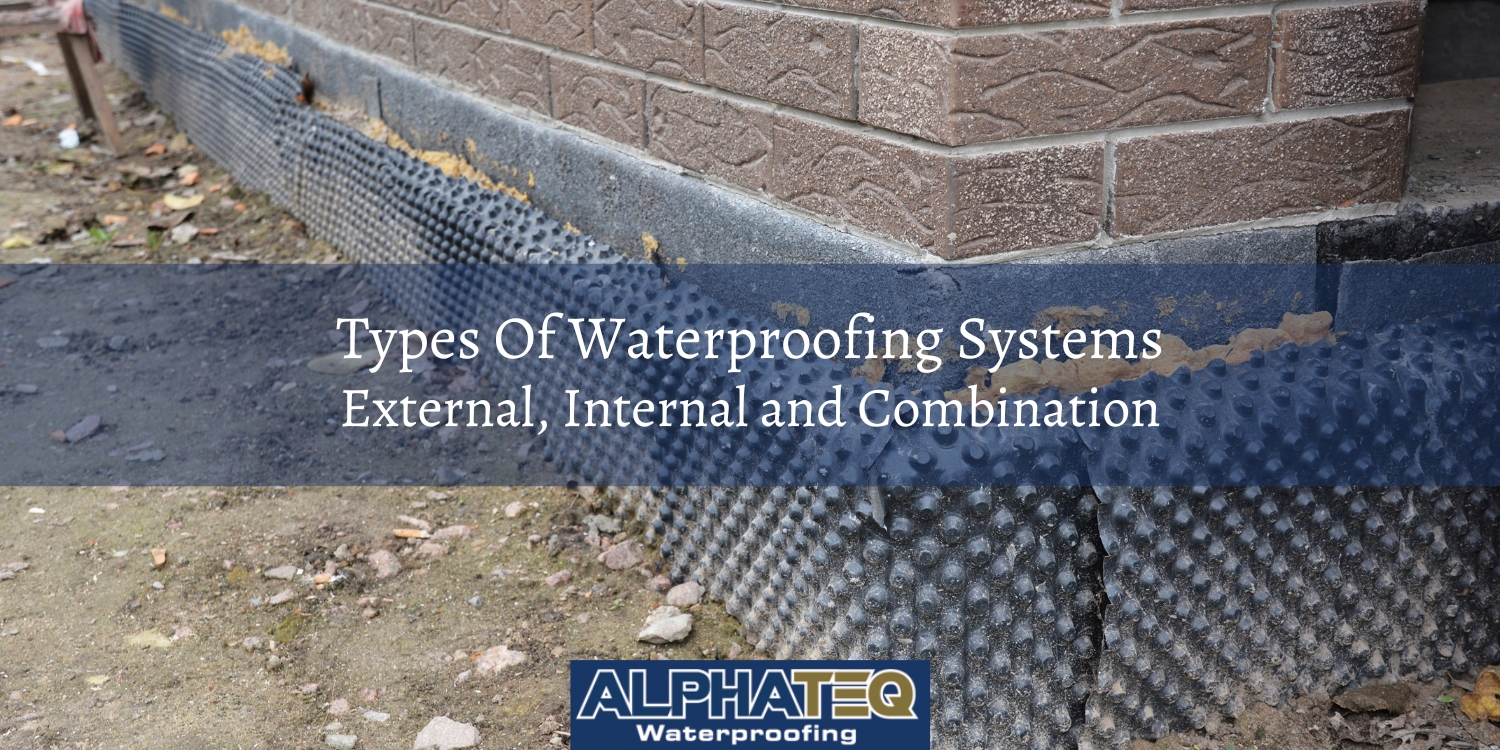
In the construction industry different systems are employed to create a barrier to protect against water infiltration. Understanding the various types of waterproofing systems allows you to select the most suitable approach for a specific project. This 3 primary categories are as follows; external, internal and combination waterproofing systems. Each system has unique characteristics, applications, and advantages.
External waterproofing methods involve applying protective barriers on the outer surface of the building to prevent water penetration. These exterior solutions are designed to withstand external water pressure and provide a robust defence against moisture intrusion. By creating a shield on the outside, external tanking systems effectively safeguard the building envelope from the damaging effects of water. External tanking systems cope with the hydrostatic pressure pushing the waterproofing membrane into the substrate.
Both a bituminous coating and a waterproofing membrane are frequently used exterior methods for waterproofing. Bitumen is a sticky and viscous material. It is applied as a coating or membrane onto the building's exterior surfaces (often a basement wall). These coatings and membranes offer excellent waterproofing properties and are resistant to UV radiation and temperature fluctuations. They create a durable and protective layer which keeps water away from the structure of the building.
Liquid-applied systems, such as liquid waterproofing membranes or spray coatings, are another approach to external waterproofing. This involves the application of liquid polymer-based coatings onto the building's exterior surfaces. The liquid forms a seamless waterproofing membrane which adheres to the substrate. This provides an effective way to prevent water infiltration. Cementitious coatings is often referred to as hydraulic cement. This is a mixture of cement, additives, and polymers, which can be used externally (often on foundation walls). These coatings form a rigid and durable layer which provides effective waterproofing and prevents moisture problems.
External systems offer several advantages. They provide a strong defence against water intrusion. This protects the building from structural damage. These systems are versatile and can be applied to various building types. This includes basement and foundation walls. These systems will extend the lifespan of the building by damp proofing the structure from the exterior and preventing any deterioration from moisture infiltration.
Just like any system, external waterproofing does have some limitations. They can be more challenging to install, as access to the exterior of the building is required. This can require some excavation. This of course can be time-consuming and increase the overall cost of the project. External waterproofing is also susceptible to damage from other trades. This is especially true in the case of landscaping activities. This means any other works being carried out will need to be done so with care. This means applying careful protection to the waterproofing. Then promptly carrying out any maintenance due to damage.
Overall, external waterproofing systems provide a robust defence against water intrusion. A protective barrier is applied to the exterior of the building. Normally in the form of a bituminous coating, waterproofing membrane, a liquid-applied systems or a hydraulic cement coating. While these systems offer numerous benefits in terms of durability and protection, factors such as cost and ease of install must be considered.
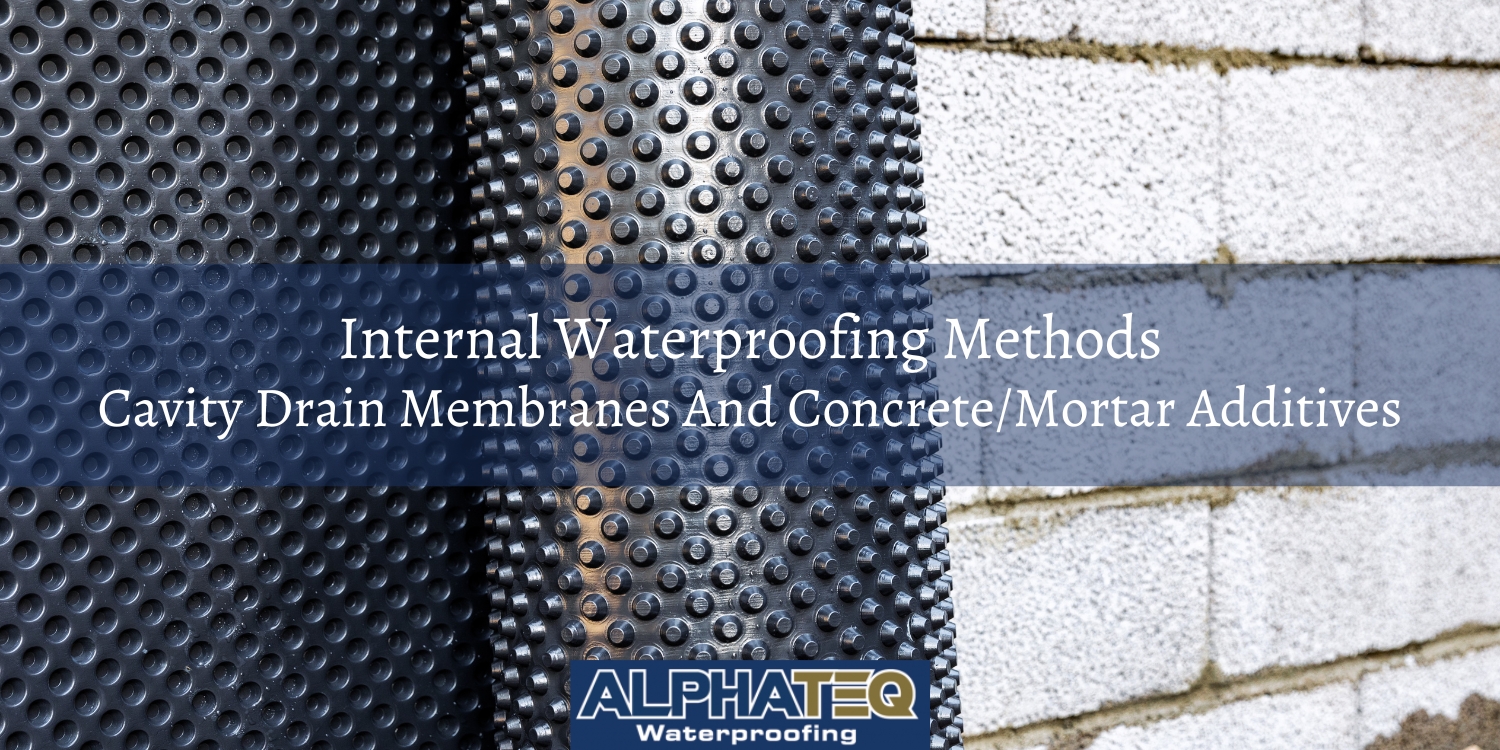
Internal systems focus on managing water intrusion from within the building. The methods used in these systems area applied internally to prevent moisture penetration. This in turn provides protection to the internal operational or living spaces of the building. Just like with external systems implementing internal waterproofing measures are designed to mitigate water penetration issues. In order to ensure a dry and healthy building. Internal tanking systems cope with the hydrostatic pressure pushing the waterproofing membrane away from the substrate.
Cavity drain membranes are often used as an internal waterproofing solution. These waterproof membranes are installed on the internal surfaces of walls or floors, creating a cavity that collects and directs water away from the building. Basement walls often make uses of these waterproof membranes. The membrane acts as a barrier, preventing water from reaching the internal finishes and structures. The collected water is then channeled using a cavity drainage system. This is often achieved with a sump pump or a drain tile.
Water-resistant additives, such as hydrophobic admixtures are combined with concrete and mortar mixes. This results in an enhanced waterproofing profile of the the concrete or mortar. These additives modify the surface tension of water, reducing its ability to penetrate the material which is being protected. The use of water-resistant additives, decreased the permeability of concrete and mortar. This is what provides the increased resistance to water infiltration.
Internal waterproofing systems offer several advantages. They provide a proactive approach to managing water intrusion. It is an effective way of directing water away from interior spaces and finishes. Internal methods are often used for waterproofing basement walls. Internal systems can be applied to both new construction and existing buildings, this shows the great flexibility of using internal waterproofing methods. Internal waterproofing has a less disruptive installation process. This is because it does not require extensive excavation or disturbance to the external surroundings.
However, internal waterproofing systems have limitations to consider. They primarily address water which has already penetrated the external barriers, rather than preventing external water intrusion. As a result, it is important the integrity of external waterproofing systems complements any internal waterproofing measures. It is important a waterproofing system is directing water away from the foundation. Like any waterproofing, proper installation and maintenance of internal systems are essential to avoid potential leaks or system failures.
In conclusion, internal systems play an important role in managing water intrusion from within the building. Cavity drain membranes and water-resistant additives in concrete and mortar are effective internal waterproofing methods. However, they should be implemented in conjunction with robust external waterproofing measures to ensure comprehensive water management and long-term effectiveness.
Combination waterproofing systems provide an integrated approach to protecting buildings from water ingress. By combining external and internal methods, these systems provide a multi-layered defence against moisture penetration.
A combination waterproofing system is one which includes the integration of both external and internal waterproofing. This provides a comprehensive and multi-layered approach to providing waterproof protection. By combining the strengths of both external and internal waterproofing, enhanced protection against moisture penetration and the reinforcement of the overall waterproofing performance of a structure is achieved.
Combination waterproofing systems employ a strategic combination of both systems of waterproofing. External waterproofing methods, such as bituminous membrane waterproofing or liquid-applied systems, are implemented to prevent water penetration from the outside. These are applied to each foundation wall. Internal waterproofing measures, such as cavity drain membranes or a masonry waterproofing product such as water-resistant additives in concrete are internal systems used. These complement the external systems by managing water which may have already penetrated the external barriers. The integration of these methods forms a comprehensive system which provides multiple layers of protection against water-related issues.
Combination waterproofing systems offer a number of advantages. They provide a holistic and integrated approach to waterproofing. This is achieved by addressing both external and internal sources of water intrusion. This comprehensive approach minimises the probability of both water damage and preserves the long term structural integrity of the building.
Combination systems are versatile and can be customised to suit various construction specification. This includes the waterproofing of basements walls, cellars, foundations walls, and concrete slabs. They offer flexibility in adapting to the specific waterproofing needs of any project. These systems can provide added peace of mind to building owners and occupants by offering an extra layer of protection against water intrusion. This further reduces the potential for future water-related issues and associated costs.
Combination waterproofing is a two component system which creates a robust and multi-layered approach to water intrusion prevention. Combination waterproofing provides enhanced protection, versatility, and long-term structural integrity. These systems are widely applicable in various construction projects and offer an effective solution to address all types of water-related issues.

When it comes to making decisions regarding waterproofing for a construction project, several factors must be considered. These are; budget, location, climate, construction materials, waterproofing techniques, building usage and occupancy requirements. By carefully evaluating these factors, the optimal decision can be made regarding the waterproofing for a specific project.
The geographical location and climate of a construction project have a direct impact on waterproofing decisions. Areas with high rainfall, frequent storms or a high water table will require robust waterproofing systems. The reason for this is they must be capable of handling a higher than average water pressure.
Regions with freeze-thaw cycles necessitate measures which are able to withstand the expansion and contraction caused by temperature fluctuations.
Any specifier needs to understand the unique challenges posed by the location and climate enables the selection of waterproofing solutions which are specifically designed to address these environmental factors.
The choice of construction materials and techniques employed in a project greatly influences the waterproofing approach. Different materials like; concrete, masonry, wood and metal have different susceptibility to water infiltration. They also require specific waterproofing methods to be used.
Techniques like poured concrete, block-work and timber frame construction will also have different vulnerabilities to water penetration. This means materials and techniques used in a project must be assessed carefully. This is to allow for the implementation of waterproofing measures which are both compatible and effective in life with the buildings own unique components.
The intended usage and occupancy requirements of the building are crucial factors when making waterproofing decisions. Considerations such as whether the building will house sensitive equipment, valuable assets, or have critical functions can lead to different levels of waterproofing being required. Healthcare facilities and food processing plants often have stringent regulations and standards for waterproofing. This to ensure hygiene and safety standards are met.
Understanding the specific needs and requirements of the building usage and occupancy are vital. Without this information selecting a waterproofing system which meet the necessary standards and provide the desired level of protection will be impossible.
Budget constraints are a significant factor in waterproofing decisions.. It is essential to strike a balance between the desired level of waterproofing and the budget available. While investing in high-quality waterproofing solutions is crucial for long-term performance. Cost-effective options which still meet the project's waterproofing requirements must be explored. Proper evaluation of the cost-effectiveness of different systems is necessary. This includes considering factors such as installation costs, maintenance requirements, and expected service. If all these factors are not taking into account it will not be possible to make an informed decision which aligns with the budget if the project.
By taking into account location and climate considerations, construction materials and techniques, building usage and occupancy requirements, as well as budget constraints and cost-effectiveness, stakeholders can make informed decisions regarding the most suitable waterproofing solutions. Assessing these factors collectively ensures that the selected waterproofing measures align with the specific project requirements and contribute to the long-term durability and performance of the structure.
Proper waterproofing in construction is crucial for several reasons. It ensures the structural longevity and integrity of the building, prevents health hazards and indoor air quality issues, minimises maintenance and repair costs, and enhances energy efficiency and sustainability. By addressing water-related challenges effectively, proper waterproofing measures contribute to the overall durability, safety, and performance of the construction project.
Water intrusion can cause significant damage to the structural components of a building over time. Moisture penetration can weaken foundations, corrode metal elements, deteriorate concrete, and compromise the overall integrity of the structure. By implementing proper waterproofing measures, water infiltration is prevented, ensuring the longevity and strength of the building's structural elements and preserving its overall stability.
Water-related issues, such as moisture buildup and mould growth, can pose serious health hazards to occupants. Mould spores released into the air can trigger respiratory problems, allergies, and other health issues. Proper waterproofing helps prevent excessive moisture, mould, and mildew from developing, thus creating a healthier indoor environment and maintaining good indoor air quality.
Water intrusion can lead to extensive damage to building components, resulting in costly repairs and maintenance. Water-damaged materials may need to be replaced, and structural repairs can be time-consuming and expensive. By implementing proper waterproofing measures from the outset, the risk of water-related damages is reduced, thereby minimising the need for extensive repairs and reducing maintenance costs in the long run.
Water leakage through the building envelope can also impact energy efficiency. Moisture intrusion can cause insulation materials to lose their effectiveness, leading to increased heat loss or gain. Additionally, water intrusion can affect the performance of HVAC systems. By effectively waterproofing the building, energy efficiency is enhanced, as heating and cooling systems can operate optimally, resulting in energy savings and contributing to overall sustainability.
In conclusion, proper waterproofing in construction is of paramount importance. It ensures the structural longevity and integrity of the building, prevents health hazards and indoor air quality issues, minimises maintenance and repair costs, and enhances energy efficiency and sustainability. By addressing water-related challenges proactively, proper waterproofing measures play a vital role in creating durable, safe, and efficient structures that withstand the test of time.
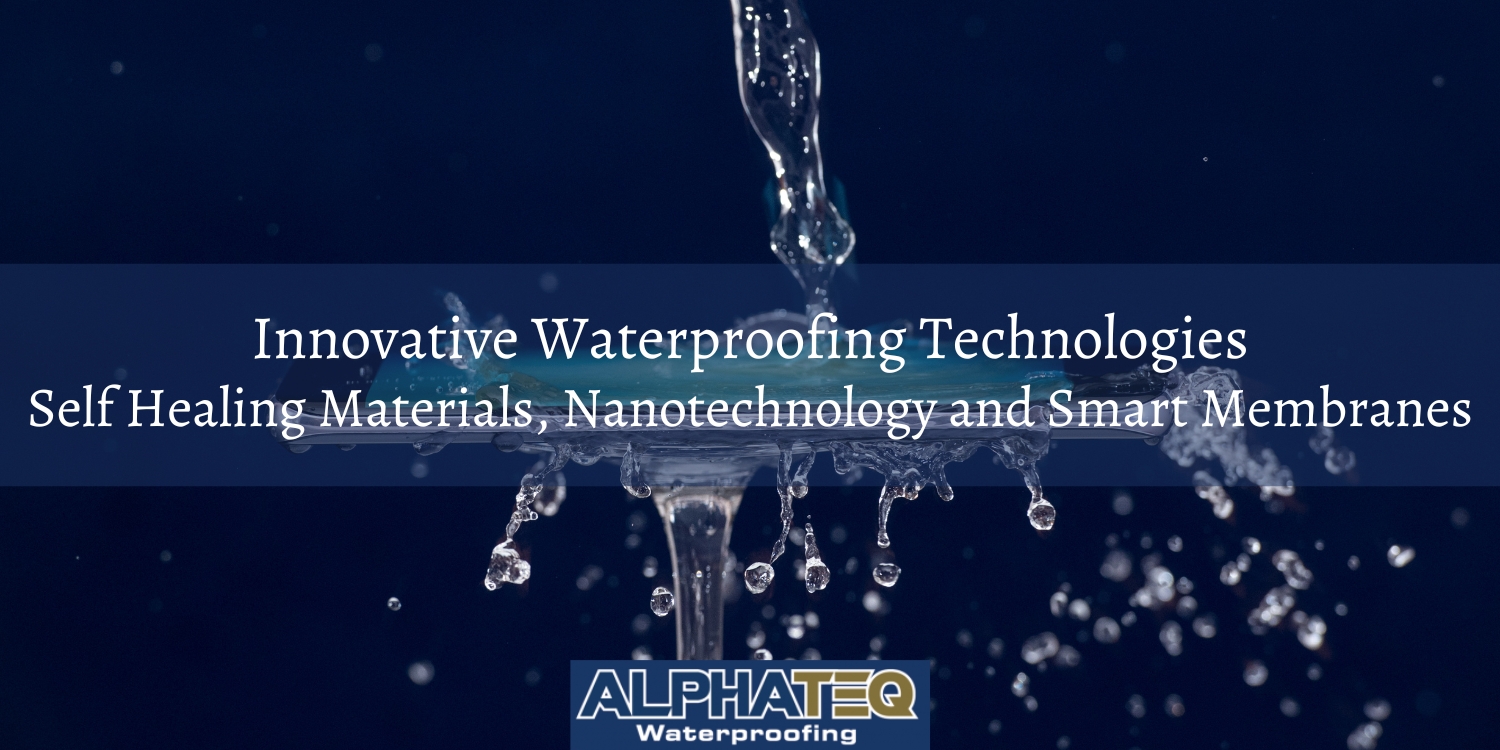
Proper waterproofing in construction requires addressing various challenges and implementing best practices to ensure long-term performance and effectiveness. By identifying potential challenges and vulnerabilities, incorporating proper design and planning, emphasising quality control during installation, and establishing regular maintenance and inspection protocols, successful waterproofing outcomes can be achieved.
Effective waterproofing begins with a thorough understanding of potential challenges and vulnerabilities specific to the construction project. Factors such as site conditions, water table levels, soil composition, and climate variations can influence the risk of water infiltration. Conducting site assessments, understanding the building's exposure to water sources, and considering potential weak points are essential steps in identifying potential challenges and vulnerabilities that need to be addressed during the waterproofing process.
A crucial aspect of waterproofing is proper design and planning. This includes selecting appropriate waterproofing materials, systems, and techniques that align with the project's requirements and environmental conditions. Integrating waterproofing into the building's design phase allows for seamless integration and ensures that critical areas, such as foundations, basements, roofs, and exterior walls, are adequately protected. Engaging with experienced waterproofing professionals and consultants can help optimise the design and planning process to achieve effective and long-lasting waterproofing solutions.
Maintaining high-quality standards during the installation of waterproofing systems is vital for their effectiveness. Proper quality control measures should be implemented to ensure that materials are applied correctly, according to manufacturer guidelines, and in accordance with industry standards. Regular inspections throughout the installation process help identify potential issues or defects early on, allowing for timely corrections and ensuring the waterproofing system's integrity.
Waterproofing systems require regular maintenance and periodic inspections to ensure their long-term performance. This includes clearing drains and gutters, inspecting seals and joints, and identifying any signs of damage or deterioration. Periodic inspections allow for the early detection of potential issues, enabling timely repairs or maintenance to prevent further damage. Implementing a maintenance plan that includes routine inspections and necessary upkeep contributes to the longevity and effectiveness of the waterproofing system.
In conclusion, addressing waterproofing challenges and following best practices are vital for successful waterproofing in construction. By identifying potential challenges and vulnerabilities, incorporating proper design and planning, emphasising quality control during installation, and establishing regular maintenance and inspection protocols, the durability and performance of the waterproofing system can be optimised. Implementing these practices ensures that structures are effectively protected against water intrusion and can withstand the test of time.
Advancements in technology have paved the way for innovative approaches to waterproofing in construction. Emerging trends and technologies offer new possibilities for enhancing the effectiveness, durability, and sustainability of waterproofing systems. In this subsection, we will explore some of these innovations, including self-healing materials and nanotechnology, hydrophobic coatings and smart membranes, as well as the impact of digitalisation and predictive analytics in waterproofing.
Self-healing materials have gained attention in the field of waterproofing. These materials possess the ability to autonomously repair micro cracks or damage that occurs over time. Through the incorporation of microcapsules or shape-memory polymers, self-healing materials can release healing agents or return to their original shape, effectively sealing cracks and maintaining the integrity of the waterproofing system. Nanotechnology, on the other hand, offers promising opportunities for enhancing the properties of waterproofing materials. Nano-structures and nano coatings can improve resistance to water penetration, increase durability, and enhance overall performance.
Hydrophobic coatings have been developed to provide exceptional water repellency. These coatings create a water-resistant barrier on the surface, preventing water from permeating the material. Hydrophobic coatings can be applied to various surfaces, including concrete, masonry, and metal, enhancing their resistance to water intrusion. Additionally, smart membranes equipped with sensors and control mechanisms have emerged in the field of waterproofing. These waterproof membranes can actively respond to environmental conditions, adjusting their permeability and sealing capabilities as needed, further enhancing the waterproofing performance.
Digitalisation and predictive analytics are revolutionising various industries, including waterproofing. Building information modelling (BIM) software allows for more accurate and efficient planning, design, and implementation of waterproofing systems. Predictive analytics can be employed to assess the performance and potential vulnerabilities of waterproofing systems based on historical data and environmental factors. Real-time monitoring systems, IoT devices, and data analytics enable proactive maintenance and early detection of potential issues, enhancing the overall effectiveness and longevity of waterproofing systems.
In summary, innovative waterproofing technologies offer exciting prospects for the construction industry. Self-healing materials, nanotechnology, hydrophobic coatings, and smart membranes bring advancements in enhancing water resistance and durability. Moreover, the integration of digitalisation and predictive analytics allows for more efficient planning, real-time monitoring, and proactive maintenance of waterproofing systems. By embracing these emerging trends and technologies, the construction industry can benefit from more effective and sustainable waterproofing solutions.
Common challenges faced during the waterproofing process include:
Common water-related issues which can be easily prevented with correct waterproofing; include water seepage through walls and floors, basement flooding, moisture intrusion (which leads to mould and mildew growth) and the deterioration of building materials due to water damage. By implementing effective waterproofing measures these issues can be significantly reduced or eliminated. These measures include; sealing cracks, applying waterproof coatings, and installing drainage systems (e.g sump pump installation, drain tile use and appropriate plumbing systems).
With balcony waterproofing factors which can promote longevity include; proper surface preparation to ensure adhesion, using high-quality BBA approved products designed for balconies, and ensuring proper slope and effective drainage to prevent water pooling.
It is not always necessary to remove the existing flooring on a balcony before applying a waterproof membrane. The decision depends on the condition of the existing flooring and the compatibility of the waterproofing system with the substrate.
The most effective techniques for basement waterproofing in areas with high water tables typically include combination systems. Exterior solutions such as installing a perimeter drainage system, applying a waterproof membrane to the exterior basement walls. Then implementing proper grading and landscaping to divert water away from the foundation. Interior waterproofing measures like sump pump system installation and using an interior drainage system can complement the exterior waterproofing and drastically reduce the probability of a wet basement.
No, basement waterproofing cannot prevent all forms of water ingress. There is a possibility you may still find yourself with a wet basement. Basement waterproofing primarily focuses on preventing water intrusion from external sources such as groundwater or surface water. This is done by applying a waterproofing layer to the basement walls. While, waterproof basement walls can help mitigate the risk of condensation by reducing moisture levels, it may not fully address humidity-related issues. Additional measures like proper ventilation and dehumidification may be necessary to control humidity in the basement.
The main factors which contribute to the deterioration of bridge deck waterproofing include:
These factors can lead to cracks, delamination, loss of adhesion, and overall degradation of the waterproofing, compromising its effectiveness in protecting the bridge deck from water infiltration and subsequent structural damage.
Yes, bridge deck waterproofing is primarily used to protect the structural elements of the bridge from water damage. These systems serve as a barrier to prevent water infiltration into the bridge deck, which helps preserve the integrity of the underlying concrete or steel components and extend the lifespan of the bridge.
Quality waterproofing can help extend the lifespan of a car park in the following ways:
It is not always necessary to completely close a car park during the application of a waterproofing coating. The feasibility of keeping sections of the car park open depends on factors such as the size of the project, accessibility to different areas, and the requirements of the waterproofing product. For specific details you should contact the manufacturers of the product used.
Different methods available for waterproofing concrete structures include:
Each method offers its own advantages and suitability depending on the specific requirements, conditions, and budget of the project.
Concrete waterproofing can be applied to existing structures after and during the construction phase. It is more convenient to incorporate waterproofing measures during the initial construction. However, retrofitting existing structures with waterproofing coatings, membranes, or injection systems is also possible. Waterproofing existing structures will enhance their resistance to water intrusion and protect against future water-related issues.
Key considerations when chosing a floor waterproofing product include; the specific requirements of the space, such as the level of moisture exposure, foot traffic, and the presence of chemicals or abrasives. Factors like the compatibility of the waterproofing product with the flooring material, ease of application, durability, and maintenance requirements should also be taken into account.
No, floor waterproofing is not only necessary in areas prone to direct water exposure. It is also beneficial in areas where moisture levels are high. This includes; below ground structures (such as basements), laundry rooms, kitchens, or any space where there is a potential for water spills or increased humidity. By applying floor waterproofing in these areas you are protecting the flooring material and prevent ing moisture-related issues.
Signs foundation waterproofing is required include; the presence of water stains or dampness on basement walls, musty odours, visible cracks or efflorescence on the foundation walls, recurrent basement flooding, or a rising water table in the area. These signs suggest water infiltration or potential issues with the foundation's ability to resist water. This suggests effective structurral waterproofing measures are needed to prevent further damage and maintain a dry and stable foundation is required.
Foundation waterproofing is typically performed during the construction of the building, specifically during the foundation stage. This is to ensure comprehensive protection against water intrusion from the beginning. However, in some cases, foundation waterproofing can be applied post-construction completion. However, it may require disruptive work in order to access and treat the existing foundation.
Foundation waterproofing and structural waterproofing are terms which are sometimes used interchangeably, but they do have distinct meanings based on the context and region in which they're used. While foundation waterproofing is a subset of structural waterproofing, focusing on the building's base, structural waterproofing is a more encompassing term. However, the correct terminology and its usage can vary depending on regional construction practices and local industry jargon. Always clarify the terms when discussing waterproofing needs with a professional company to ensure you're getting the ideal solution for your situation.
PMMA-based waterproofing systems offer several advantages over other materials. They have fast curing times, allowing for quicker project completion, and exhibit excellent UV resistance and durability, making them suitable for exposed and high-traffic areas. Additionally, PMMA-based systems have good flexibility, crack-bridging capabilities, and superior adhesion to various substrates, providing reliable and long-lasting waterproofing solutions.
Yes, PMMA waterproofing systems can be applied to both horizontal and vertical surfaces. The liquid nature of the PMMA resin allows for seamless and efficient application on a variety of substrates, making it versatile for waterproofing horizontal decks, vertical walls, and even complex geometries.
Polyurea waterproofing differs from other methods in terms of its application and performance. Polyurea waterproofing is a spray-applied coating that cures rapidly, forming a seamless, flexible, and durable membrane. Polyurea exhibits excellent resistance to water, chemicals, abrasion, and UV exposure, making it a versatile choice for waterproofing applications where a quick installation, high performance, and long-term durability are desired.
Polyurea waterproofing can be used as a standalone solution, as it offers excellent durability and resistance to water and other environmental factors. However, in certain cases, additional protective coatings or topcoats may be applied to enhance specific properties such as UV resistance or aesthetics, depending on the project requirements and desired outcomes.
Polyurethane sealants are commonly used in various waterproofing projects, including sealing joints and gaps in building exteriors, such as windows, doors, and expansion joints. They are also used for sealing cracks in concrete structures, filling gaps in roofing systems, and providing flexible and durable waterproofing solutions in areas prone to movement or vibration.
Polyurethane sealant is suitable for both interior and exterior waterproofing applications. Its versatility, adhesion properties, and ability to withstand a wide range of temperatures and environmental conditions make it a popular choice for sealing joints and gaps in both interior and exterior surfaces to prevent water infiltration.
When waterproofing steps, key considerations include selecting a durable and slip-resistant waterproofing material that can withstand foot traffic and exposure to the elements. Proper surface preparation, such as cleaning and repairing any existing damage, is crucial for ensuring optimal adhesion of the waterproofing product. Additionally, incorporating proper drainage and ensuring proper integration with adjacent waterproofing systems are essential to maintain the safety and longevity of the waterproofed steps.
Yes, step waterproofing systems can effectively prevent water seeping and leakage in high-traffic areas when applied correctly. By using durable and slip-resistant waterproofing materials and ensuring proper installation and maintenance, step waterproofing systems can provide an effective barrier against water intrusion, protecting the underlying structure and ensuring safety in high-traffic areas.
Hydrostatic pressure is the force exerted by a fluid, such as water, at rest, due to its weight and gravity. It is the pressure that exists in a fluid at any given depth and increases with the depth of the fluid. In waterproofing, hydrostatic pressure often refers to the pressure exerted by groundwater against the foundation or structure's below-ground surfaces. If not properly managed, this pressure can lead to water infiltration and damage.
Hydrostatic pressure can manifest in various forms, including:
Effective waterproofing strategies must account for these different types of hydrostatic pressure to prevent water from infiltrating and causing damage to buildings or structures.
If you would like further information about waterproofing in construction we can help. Please get in touch with us through our contact form or call us on 01277 503 110. One of our team of waterproofing experts will be happy to help.